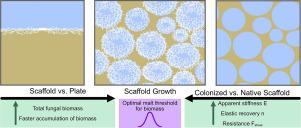木耳无根灵芝在多孔支架中的菌丝生长
IF 10.2
1区 医学
Q1 ENGINEERING, BIOMEDICAL
引用次数: 0
摘要
丝状木真菌菌丝体表现出受寄主材料影响的适应性生长策略。在二维固态发酵中,密实的底物限制了氧气的进入,导致菌丝主要在底物-空气界面生长。为了解决这一挑战,我们研究了开放多孔支架作为丝状真菌无根灵芝的生长环境,通过麦角甾醇含量来量化菌丝生物量的形成。这种定量方法直接证明,与平板培养相比,支架相关的生物量在7天后增加了60%,因此提供了实验证据,证明多孔基质中可接近表面积的增加与固态真菌生长中生物量形成的增强有关。菌丝定植的水凝胶支架也提高了其力学性能,包括刚度和弹性恢复。在G. lucidum或P. ostreatus中没有观察到这种与支架相关的生物量增加,这强调了G.sessile麦角甾醇水平在基质中麦芽提取物含量为2 wt%时达到峰值的物种特异性效应,与较高和较低浓度的麦芽提取物相比。这些发现提高了我们对固态发酵的理解,强调了物种特异性反应的重要性,并指导了真菌基材料的底物设计。本文章由计算机程序翻译,如有差异,请以英文原文为准。

Mycelial growth of wood fungus Ganoderma sessile in porous scaffolds
The mycelium of filamentous wood fungi exhibits adaptive growth strategies influenced by their host material. In 2D solid-state fermentation, densely packed substrates limit oxygen access, resulting in hyphal growth mainly at the substrate-air interface. To address this challenge, we investigated open porous scaffolds as growth environments for the filamentous fungus Ganoderma sessile, quantifying mycelial biomass formation via ergosterol content. This quantitative approach directly demonstrates a scaffold-associated biomass increase of 60% after 7 days compared to plate cultures and thus provides experimental evidence linking increased accessible surface area in porous substrates to enhanced biomass formation in solid-state fungal growth. Mycelium colonization of the hydrogel scaffold also enhanced their mechanical properties, including stiffness and elastic recovery. This scaffold-associated biomass increase was not observed for G. lucidum or P. ostreatus, underscoring a species-specific effect with ergosterol levels for G.sessile peaking at 2 wt% malt extract in the substrate, in contrast to both higher and lower malt extract concentrations. These findings improve our understanding of solid-state fermentation, highlight the importance of species-specific responses and guide the design of substrates for fungi-based materials with tailored properties.
求助全文
通过发布文献求助,成功后即可免费获取论文全文。
去求助
来源期刊

Materials Today Bio
Multiple-
CiteScore
8.30
自引率
4.90%
发文量
303
审稿时长
30 days
期刊介绍:
Materials Today Bio is a multidisciplinary journal that specializes in the intersection between biology and materials science, chemistry, physics, engineering, and medicine. It covers various aspects such as the design and assembly of new structures, their interaction with biological systems, functionalization, bioimaging, therapies, and diagnostics in healthcare. The journal aims to showcase the most significant advancements and discoveries in this field. As part of the Materials Today family, Materials Today Bio provides rigorous peer review, quick decision-making, and high visibility for authors. It is indexed in Scopus, PubMed Central, Emerging Sources, Citation Index (ESCI), and Directory of Open Access Journals (DOAJ).
 求助内容:
求助内容: 应助结果提醒方式:
应助结果提醒方式:


